
| Red-lined Geometrid (erroneously : Phalaena occultaria Guenée, 1857) GEOMETRINAE, GEOMETRIDAE, GEOMETROIDEA | (donherbisonevans@yahoo.com) and Stella Crossley |
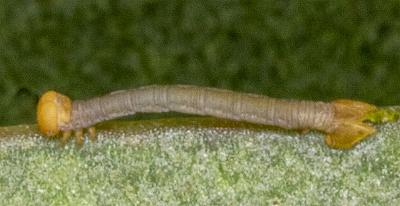
close-up of first instar
(Photo: courtesy of
David Akers,
Won Wron, Victoria)

| Red-lined Geometrid (erroneously : Phalaena occultaria Guenée, 1857) GEOMETRINAE, GEOMETRIDAE, GEOMETROIDEA | (donherbisonevans@yahoo.com) and Stella Crossley |

close-up of first instar
(Photo: courtesy of
David Akers,
Won Wron, Victoria)
The first instar of this Caterpillar is grey, with a rounded yellow head and a fork at the rear.
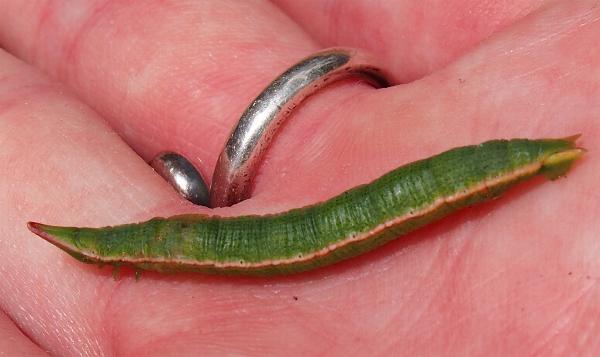
In later instars, the head changes to taper to a point at the front, and a pale red-edged yellow lateral line develops, extending each side from the tip of the head to the tip of the tail.
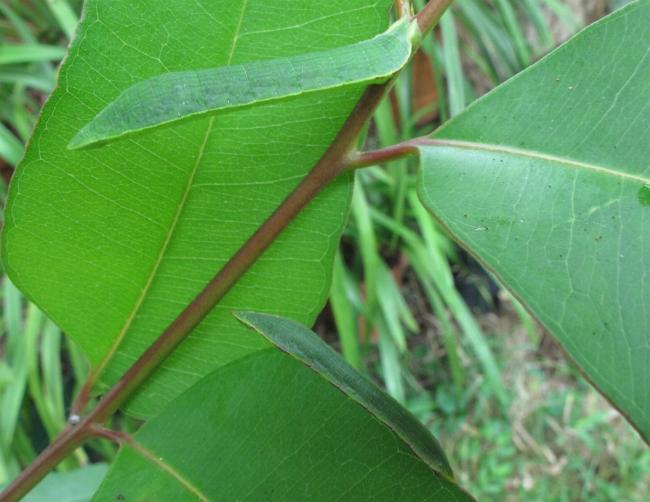
These later instars rest with the true legs tucked forwards around the mouth parts, so that its head capsule is almost hidden.
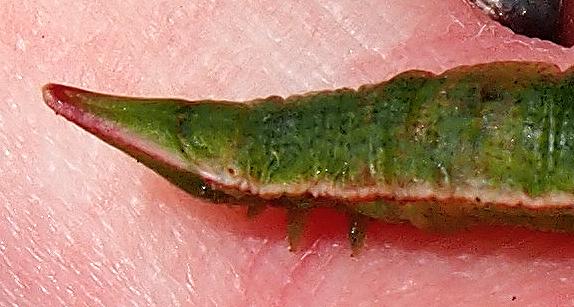
The caterpillar feeds on the leaves of
To feed, the first instar bends over the leaf and eats the surface layer. Later instars eat the whole leaf from the edge inwards. The caterpillar moves very little, clinging to the same position on the same leaf for several days at a time. When it does move, mouth parts and legs separate and point downwards. This makes the projection behind the head point upwards, like a conical hat.
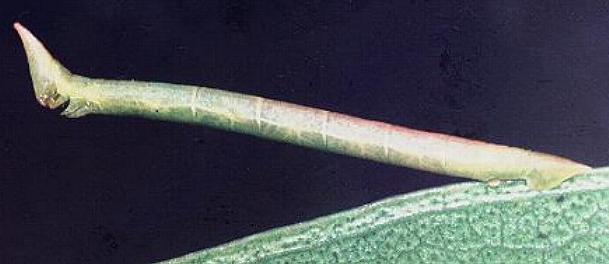
The caterpillar looks pretty as it 'tip toes' along a leaf: first the front end moves ahead, then the rear end loops forward to join it.
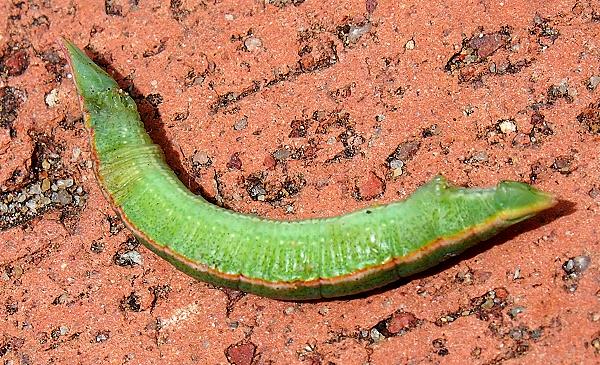
When disturbed, the Caterpillar stands out stiffly like a twig. standing on its anal prolegs and the single pair of ventral prolegs. This is fine if it is on a twig, but is conspicuous when it happens to be on the edge of a leaf. Perhaps their normal predators are too silly to notice.

In captivity the caterpillars pupated four weeks after hatching from the egg. The pupa was formed in the soil. The adult moths emerged two weeks after pupation in February in Melbourne.
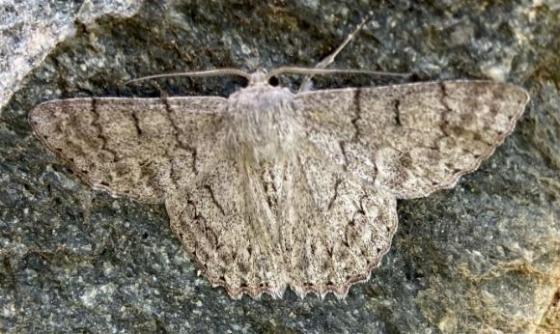
The adult is unsurprising. Its upper surfaces are a dull grey marked with dark irregular lines.
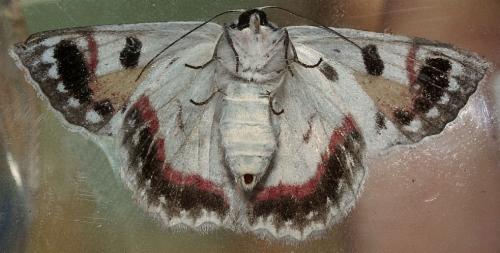
But the undersides are strikingly patterned. They are pale grey, with black submarginal bands, bordered on the inside with red, and the forewings each have a large black spot and an orange patch.
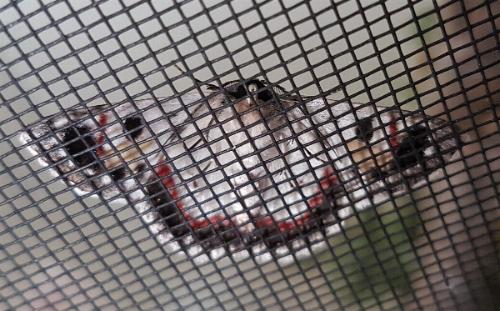
The males have comb-like antennae. The females have thread-like antennae. The moths usually rests with their wings outspread. The moths have a wingspan of about 4 cms.
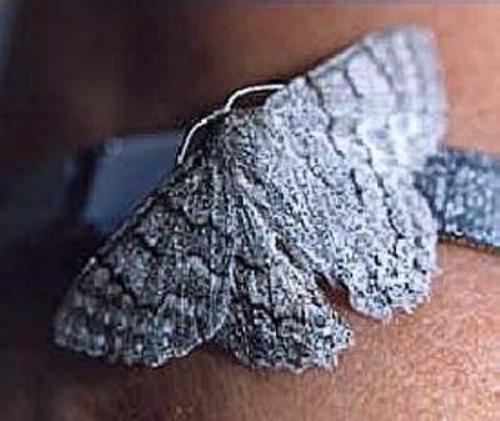
The eggs of this species are ovoid and green, and minutely pitted. They are laid irregularly along the edge of a leaf of the foodplant. They take about five days to hatch in captivity.
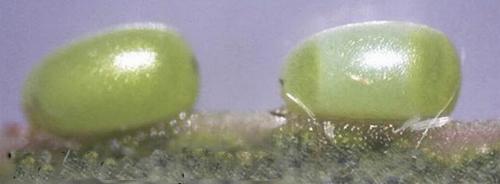
The species is found over much of Australia, including:
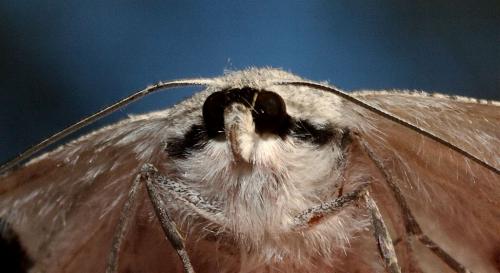
Further reading :
David Carter,
Butterflies and Moths,
Collins Eyewitness Handbooks, Sydney 1992, p. 195.
Ian F.B. Common,
Moths of Australia,
Melbourne University Press, 1990, fig. 37.12, p. 372.
Pat and Mike Coupar,
Flying Colours,
New South Wales University Press, Sydney 1992, p. 43.
Edward Donovan,
General Illustration of Entomology,
An Epitome of the Natural History of the Insects of
New Holland, New Zealand, New Guinea, Otaheite and other
Islands in the Indian, Southern and Pacific Oceans,
London (1803), p. 164, and also
Plate, p. 162.
Peter B. McQuillan, Jan A. Forrest, David Keane, & Roger Grund,
Caterpillars, moths, and their plants of Southern Australia,
Butterfly Conservation South Australia Inc., Adelaide (2019), p. 138.
Peter Marriott,
Moths of Victoria: Part 4,
Emeralds and Allies - GEOMETROIDEA (B),
Entomological Society of Victoria, 2012, pp. 30-31.
Paul Zborowski and Ted Edwards,
A Guide to Australian Moths,
CSIRO Publishing, 2007, p. 139.
 caterpillar |  butterflies |  Lepidoptera |  moths |  caterpillar |
(updated 29 June 2013, 21 October 2025)